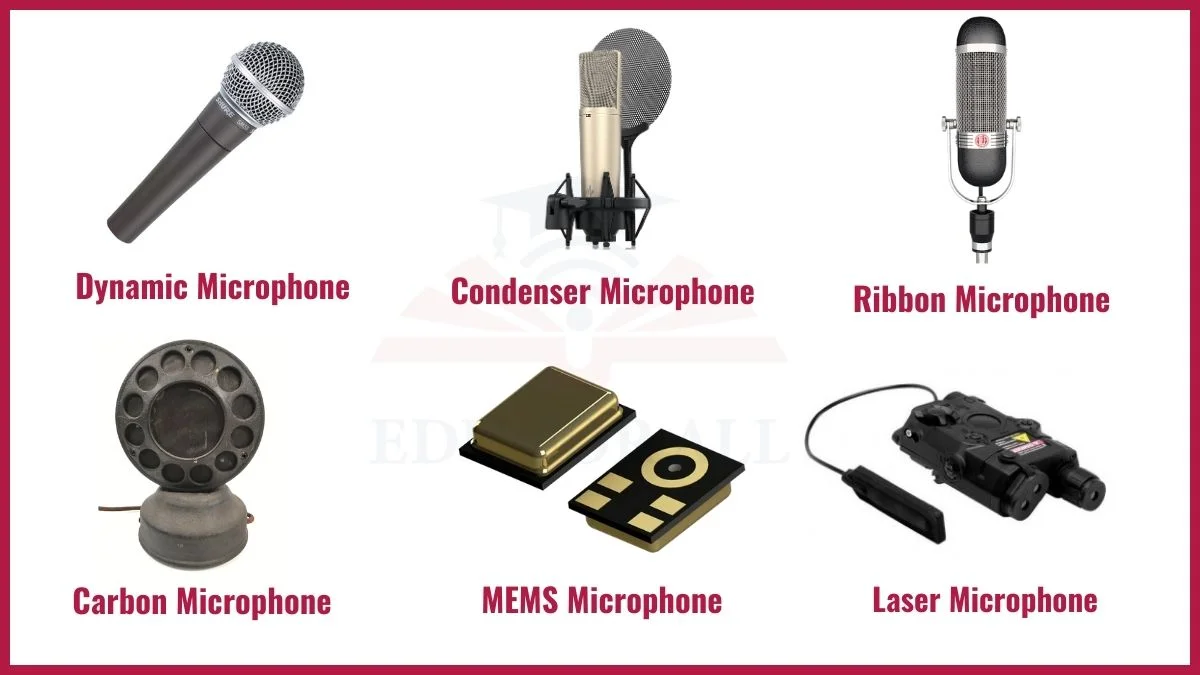A microphone captures sound waves in the air and transforms them into electrical signals. It makes them understandable by electronic devices such as computers or amplifiers.
Examples of microphones include dynamic microphones, condenser microphones, ribbon microphones, carbon microphones, and more.
Examples of Microphones
Here are the best examples of microphones:

1. Dynamic Microphone
The best example of a microphone is a dynamic microphone. It works by converting sound waves into an electrical audio signal. The diaphragm, voice coil, and magnet convert the sound waves. It captures ambient sound (background or surrounding noise) and converts it into an electrical signal.
Dynamic microphones handle high volume levels well. They are sturdy. They don’t require external power.
2. Condenser Microphone
A condenser microphone records sound waves as electrical signals. It uses a diaphragm and a backplate. The diaphragm and backplate convert audio sound energy into electrical signals by using capacitance changes. It converts acoustical (hearing) sound energy into an electrical signal.
Condenser microphones capture subtle nuances well. They are more sensitive than dynamic mics.
3. Ribbon Microphone
A ribbon microphone is also one of the best examples of a microphone. It generates an electrical current when sound causes the ribbon to vibrate. A thin aluminum ribbon suspends in a magnetic field. The ribbon’s vibration from sound waves creates an electrical representation of the acoustic energy. It converts the sound waves into an electrical signal.
Ribbon microphones handle high volume levels without distorting the sound.
4. Carbon Microphone
A carbon microphone varies electrical resistance when sound waves compress the carbon. It uses granules (small particles) of carbon. The changing resistance converts the acoustic vibrations into electrical signals. It converts the acoustic vibrations into electrical signals.
Carbon microphones have been widely used in telephones for over 100 years.
5. MEMS Microphone
A MEMS microphone converts sound into an electrical signal using microscopic mechanical and electronic components. It detects sound and pressure variations from sound waves. The pressure variations create electrical signals through the microscopic components. It converts sound into an electrical signal.
MEMS microphones are small and inexpensive to manufacture.
6. Piezoelectric Microphone
A piezoelectric microphone converts sound waves into electrical signals. It uses the piezoelectric effect. Pressure on the materials produces an electrical charge. The pressure vibrates a piezoelectric material inside. It transforms the mechanical energy into analog electrical signals.
Piezoelectric microphones work in high temperatures. They are waterproof.
7. Laser Microphone
A laser microphone detects movements from sound waves. It aims a laser beam at a surface. The surface vibrates from the sound waves. It analyzes the reflection of the laser light. It senses acoustic (audio) pressure levels. It converts them into electrical signals by detecting the movements.
Laser microphones collect sound from great distances. They aim at surfaces like windows. The windows vibrate with voices in rooms.
8. Fiber Optic Microphone
A fiber optic microphone converts sound into light. It transmits the light through optical fibers. A thin diaphragm vibrates with sound waves. The diaphragm reflects light based on the sound waves. It transforms sound energy into optical and electrical signals.
Fiber optic microphones withstand electromagnetic interference. Electrical microphones get disrupted.
9. Liquid Microphone
A liquid microphone translates acoustic (sound into electrical signals. It has a diaphragm contacting liquid. The diaphragm vibrates from the sound waves. This causes light modulations in the liquid. The changing light properties are decoded into electrical signals.
Liquid microphones have no moving parts except the diaphragm.
10. MEMS Digital Microphone
A digital MEMS microphone consists of a pressure-sensitive diaphragm and an analog-to-digital converter on a single chip that produces a digital output signal directly from the sound. It qualifies as a microphone because the diaphragm converts acoustic (audio) waves into analog electrical signals, and the converter transforms the analog signals into digital data.
Digital MEMS microphones simplify integrating microphones with digital devices since they output digital data directly without needing additional external components.

